

Les grands dauphins sauvages s'appellent par leur nom. Les singes reconnaissent les chasseurs. EQUATEUR, PARC NATIONAL DE YASUNI : un singe laineux commun assis sur une branche dans le parc national de Yazuni en Equateur en novembre 2012. © AFP PHOTO/Pablo COZZAGLIO.
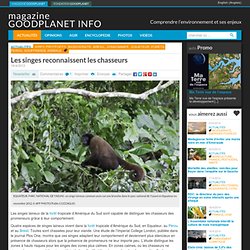
Les corneilles sont-elles assez intelligentes pour faire de la planche à neige? Un chimpanzé sait en aider un autre... en lui tendant le bon outil. Animals balance threat of starvation with threat of predators to stay alive. (Phys.org)—In the natural world, searching for food is a high-stakes game in which animals risk starving to death or being killed by a predator.
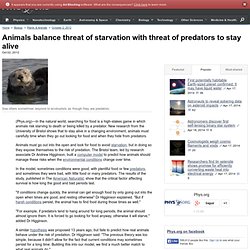
New research from the University of Bristol shows that to stay alive in a changing environment, animals must carefully time when they go out looking for food and when they hide from predators. Animals must go out into the open and look for food to avoid starvation, but in doing so they expose themselves to the risk of predation. The Bristol team, led by research associate Dr Andrew Higginson, built a computer model to predict how animals should manage these risks when the environmental conditions change over time. Salmon and other fish predators rely on 'no guts, no glory' survival tactic. The phrase "no guts, no glory" doesn't just apply to athletes who are striving to excel.
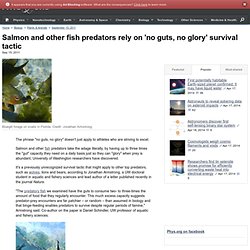
Salmon and other fish predators take the adage literally, by having up to three times the "gut" capacity they need on a daily basis just so they can "glory" when prey is abundant, University of Washington researchers have discovered. It's a previously unrecognized survival tactic that might apply to other top predators, such as wolves, lions and bears, according to Jonathan Armstrong, a UW doctoral student in aquatic and fishery sciences and lead author of a letter published recently in the journal Nature. "The predatory fish we examined have the guts to consume two- to three-times the amount of food that they regularly encounter. Témoignage supplémentaire de l’intelligence et de l’amitié des dauphins envers les humains. Deformed Dolphin Accepted Into New Family.
National Geographic, January 23, 2013 Deformed Dolphin Accepted Into New Family Lone dolphin with spinal deformity travels among a group of sperm whales.
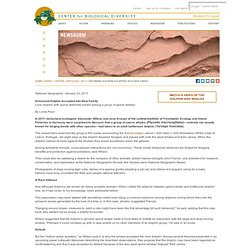
By Linda Poon In 2011, behavioral ecologists Alexander Wilson and Jens Krause of the Leibniz-Institute of Freshwater Ecology and Inland Fisheries in Germany were surprised to discover that a group of sperm whales (Physeter macrocephalus)—animals not usually known for forging bonds with other species—had taken in an adult bottlenose dolphin (Tursiops truncatus). Gift Giving by Wild Bottle nose Dolphins (Tursiops sp.) to Humans. Authors: Holmes, Bonnie J.; Neil, David T.
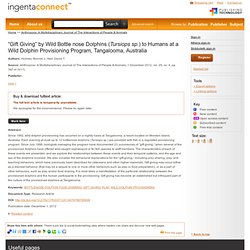
Source: Anthrozoos: A Multidisciplinary Journal of The Interactions of People & Animals, 1 December 2012, vol. 25, no. 4, pp. 397-413(17) Publisher: Buy & download fulltext article: The full text article is temporarily unavailable. We apologise for the inconvenience. Wild Dolphins Observed Giving Gifts to Humans. DocklandsTony/CC BY-SA 2.0 While it's already well known that dolphins rank among the most intelligent creatures on the planet, new research is suggesting that they just might be one of the most magnanimous too.
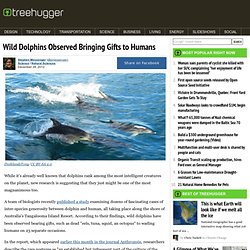
A team of biologists recently published a study examining dozens of fascinating cases of inter-species generosity between dolphin and human, all taking place along the shore of Australia's Tangalooma Island Resort. BBC Nature - Dolphins try to save dying companion. 28 January 2013Last updated at 07:40 By Matt Walker Editor, BBC Nature Common dolphins have been seen gathering to aid a dying companion, trying to support it in the water and help it breathe.
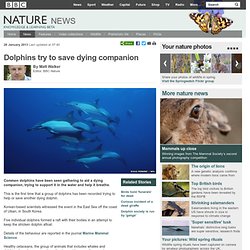
This is the first time that a group of dolphins has been recorded trying to help or save another dying dolphin. Korean-based scientists witnessed the event in the East Sea off the coast of Ulsan, in South Korea. Five individual dolphins formed a raft with their bodies in an attempt to keep the stricken dolphin afloat. Details of the behaviour are reported in the journal Marine Mammal Science.
Healthy cetaceans, the group of animals that includes whales and dolphins, have been seen attempting to provide supportive care to individuals before. Dolphins are 'people' say scientists - World news, News. By John von Radowitz in Vancouver – 21 February 2012 A small group of experts in philosophy, conservation and dolphin behaviour were canvassing support for a "Declaration of Rights for Cetaceans".
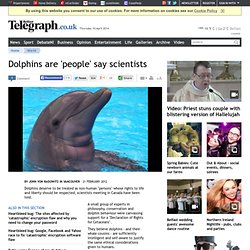
They believe dolphins - and their whale cousins - are sufficiently intelligent and self-aware to justify the same ethical considerations given to humans. Recognising cetaceans' rights would mean an end to whaling and the captivity of dolphins and whales, or their use in entertainment. Bonobo genius makes stone tools like early humans did - life - 21 August 2012. Video: Watch this bonobo go to all ends to get food Kanzi the bonobo continues to impress.
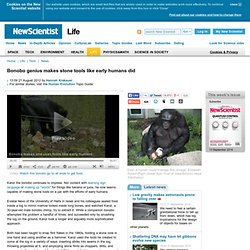
Not content with learning sign language or making up "words" for things like banana or juice, he now seems capable of making stone tools on a par with the efforts of early humans. Des Grands Hérons se rapprochent de Pygargues à tête blanche pour nicher. Dans le nord-ouest de l'Amérique du Nord, les Grands Hérons ont adopté un comportement curieux pour faire face à la croissance de la population de pygargues.

Nous avons déjà publié sur Ornithomedia.com un article évoquant les conséquences inattendues de la croissance récente des populations de pygargues en Europe et en Amérique du nord au cours du 20ème siècle (lire Les conséquences inattendues du retour des pygargues dans l'hémisphère nord). Ce rétablissement a en effet eu des effets sur les populations d'oiseaux marins : ces rapaces tuent des adultes et des jeunes et les stressent, favorisant indirectement des prédateurs opportunistes comme les goélands et les corbeaux.
Il existe d'autres exemples d'associations entre rapaces et oiseaux pouvant pourtant constituer des proies potentielles pour les premiers (lire Le Faucon crécerellette et le Choucas des tours peuvent coopérer pour nicher). Les moustaches du phoque, un véritable outil de mesure. Staff List. Research Interests My research has mainly focussed on characterising the behaviour and physiology of whisker touch systems in mammals. Specific projects I am involved in are: Comparative physiology of whisker touch including whisker muscle studies in collaboration with the Weizmann Institute, Israel. Comparative active touch behaviours focusing on rats, mice, dormice, opossums, harbour seals, sealions and humans; in collaboration with the University of Sheffield, UK, Wildwood Trust, UK, Blackpool Zoo, UK and the Marine Science Center, Germany.
Selected Publications Grant, R.A., Itskov, P.M., Towal, B. & Prescott, T.J. (2014). Great tits search for, capture, kill and eat hiber... [Biol Lett. 2010. Éloge de l'animal.